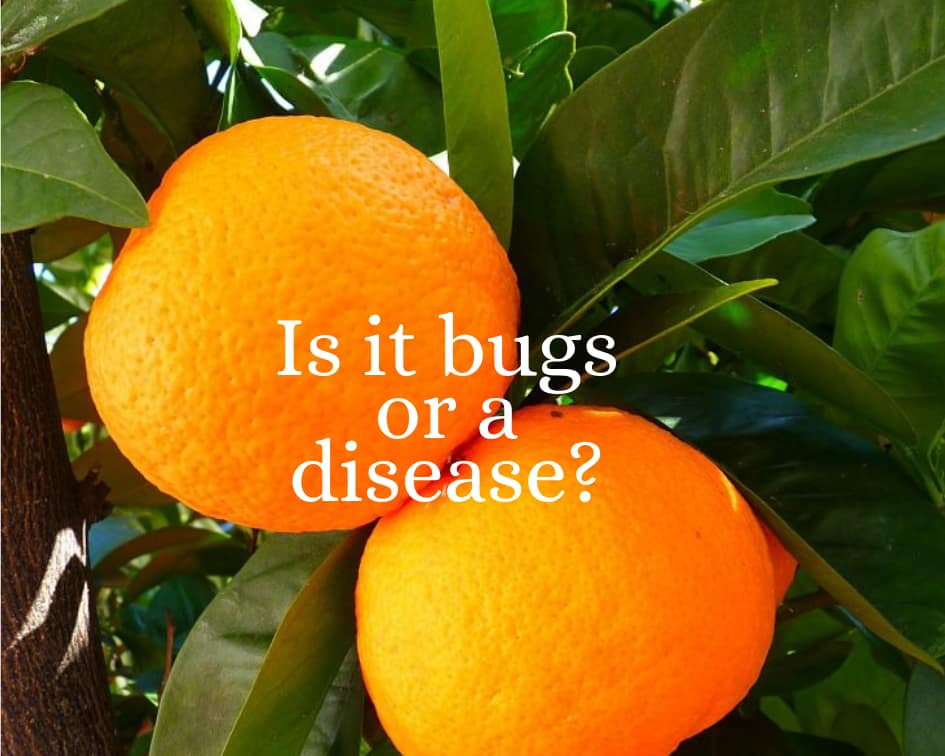This post may contain affiliate links. As an Amazon Associate we earn from qualifying purchases.
Citrus tree problems can be frightening, so let’s learn about how to avoid them.
It’s easy to panic when your prized citrus tree begins sending out distress signals. Even with the best care, however, weather, bugs and fungal pathogens can cause the citrus tree problems. If your tree is looking rather poorly, get to work treating and caring for it.
What ails your citrus tree?
Before you can tackle citrus tree problems you need to know why it’s sick. Pests, disease organisms and improper cultural practices are typically the culprits when a citrus tree declines.
Sometimes it isn’t easy to determine what ails the tree. Yellow foliage, for instance, may be a sign of insect infestation; chlorosis (a nutrient deficiency); overwatering; winter yellows (which is caused by cold soil); fertilizer or pesticide burn or excess soil salinity. Once you know what is causing the sickness you can treat it appropriately.
Consult with your local Cooperative Extension agent for assistance in identifying the problem (you’ll find a state-by-state directory of extension offices here) or try to i.d. them yourself online at the United States Department of Agriculture’s IDTools website.
Prune the citrus tree
After treating the citrus tree problem, it may be necessary to prune it to stop the spread of a disease. Typically you’ll need to cut out all dead and diseased wood.
If the tree contains an abundance of dead twigs, branches, leaves and misshapen or scarred fruit, a complete rejuvenation may be in order. Sean O’Brien, of Hunter Valley Gardens, suggests using a power saw to cut the outside limbs of the tree back to a more manageable size and then using pruning shears to cut individual twigs from larger branches. The final task involves using loppers to cut out any wayward-growing branches – those that cross over others and those that grow straight up or down or towards the middle.
Although this type of drastic pruning may decrease production for a season or two, it may help you to save the tree (depending on the tree’s problem) and encourage new, healthy growth.
Fertilize citrus trees
Once the problem with the tree has been addressed and it’s on the mend, it’s time to fertilize it to help strengthen it and encourage new growth. Wait until February to begin the fertilizer regime. This is when you will give the citrus tree its first dose of nitrogen, which will be reapplied again in July and September.
If the cause of the tree’s sickness is a mineral deficiency, consider applying a complete citrus food as well. Manure is a source of organic nutrition and should be applied in the fall.
Control insects
Not only does the Asian citrus psyllid — an insect that resembles an aphid –feed on the stems and leaves of citrus trees, it transmits Huanglongbing, a deadly bacterial disease. Also known as citrus greening disease, it affects the tree’s fruit and it has no cure. Therefore, prevention of the disease, by controlling the citrus psyllid, is critical.

The first step in controlling the insect is to avoid bringing citrus trees from other states and, even if you live in California, from the southern part of the state to the northern.
Use a magnifying glass to look for the insect’s bright yellow eggs on new, unfolded leaves. You may need to inspect inside the folds of the leaves to find the eggs.
Eradication of the pest should be based on the advice from your County Agricultural Commissioner, who will send someone to inspect the tree and recommend treatment. Enter your zip code in the box provided at the Citrus Research Board’s website to get the phone number of the office in your area.



